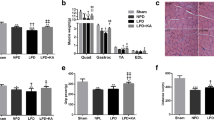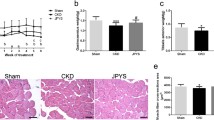Abstract
Background
Muscle wasting is common in patients with chronic kidney disease (CKD). Many studies report that mitochondrial dysfunction and endoplasmic reticulum (ER) stress are involved in the development of muscle wasting. However, treatment approaches to protect against muscle wasting are limited. In this study, we investigated the benefits and potential mechanism of Mito-TEMPO, a mitochondria-targeted antioxidant on uremic-induced muscle wasting.
Methods
Mice were randomly divided into four groups as follows: control group, CKD group, CKD + Mito-TEMPO group, and Mito-TEMPO group. Renal injury was assessed by measurement of serum creatinine and BUN along with PAS and Masson’s staining. Bodyweight, gastrocnemius muscle mass, grip strength, and myofiber cross-sectional areas were investigated to evaluate muscle atrophy. Muscle protein synthesis and proteolysis were evaluated by Western blot and real-time PCR. Inflammatory cytokines including TNF-α, IL-6, IL-1β, and MCP-1 were measured by ELISA kits. Oxidative stress markers such as SOD2 activity and MDA level in gastrocnemius muscle tissue were measured by colorimetric assay. Mitochondrial dysfunction was evaluated by transmission electron microscopy and real-time PCR. ER stress was evaluated by Western blot.
Results
Impaired renal function was significantly restored by Mito-TEMPO treatment. Severe muscle atrophy was observed in muscle tissues of CKD mice along with increased inflammatory factors, oxidative stress markers, mitochondrial dysfunction, and ER stress. However, these effects were significantly attenuated with Mito-TEMPO treatment.
Conclusions
Mito-TEMPO improved muscle wasting in CKD mice possibly through alleviating mitochondrial dysfunction and endoplasmic reticulum stress, providing a potential new therapeutic approach for preventing muscle wasting in chronic kidney disease.







Similar content being viewed by others
References
Stevens PE, Levin A (2013) Evaluation and management of chronic kidney disease: synopsis of the kidney disease: improving global outcomes 2012 clinical practice guideline. Ann Intern Med 158(11):825–830
Hoerger TJ, Simpson SA, Yarnoff BO, Pavkov ME, Rios BN, Saydah SH, Williams DE, Zhuo X (2015) The future burden of CKD in the United States: a simulation model for the CDC CKD initiative. Am J Kidney Dis 65(3):403–411
Workeneh BT, Mitch WE (1132S) Review of muscle wasting associated with chronic kidney disease. Am J Clin Nutr 91(4):1128S–1132S
Chao CT, Tang CH, Cheng RW, Wang MY, Hung KY (2017) Protein-energy wasting significantly increases healthcare utilization and costs among patients with chronic kidney disease: a propensity-score matched cohort study. Curr Med Res Opin 33(9):1705–1713
Wang XH, Mitch WE (2014) Mechanisms of muscle wasting in chronic kidney disease. Nat Rev Nephrol 10(9):504–516
Wang XH, Mitch WE (2013) Muscle wasting from kidney failure-a model for catabolic conditions. Int J Biochem Cell Biol 45(10):2230–2238
Thomas SS, Mitch WE (2013) Mechanisms stimulating muscle wasting in chronic kidney disease: the roles of the ubiquitin-proteasome system and myostatin. Clin Exp Nephrol 17(2):174–182
Du J, Hu Z, Mitch WE (2005) Molecular mechanisms activating muscle protein degradation in chronic kidney disease and other catabolic conditions. Eur J Clin Invest 35(3):157–163
Pieczenik SR, Neustadt J (2007) Mitochondrial dysfunction and molecular pathways of disease. Exp Mol Pathol 83(1):84–92
Wang D, Chen J, Liu X, Zheng P, Song G, Yi T, Li S (2017) A Chinese herbal formula, Jian-Pi-Yi-Shen decoction, improves muscle atrophy via regulating mitochondrial quality control process in 5/6 nephrectomised rats. Sci Rep 7(1):9253
Tamaki M, Miyashita K, Wakino S, Mitsuishi M, Hayashi K, Itoh H (2014) Chronic kidney disease reduces muscle mitochondria and exercise endurance and its exacerbation by dietary protein through inactivation of pyruvate dehydrogenase. Kidney Int 85(6):1330–1339
Su Z, Klein JD, Du J, Franch HA, Zhang L, Hassounah F, Hudson MB, Wang XH (2017) Chronic kidney disease induces autophagy leading to dysfunction of mitochondria in skeletal muscle. Am J Physiol Renal Physiol 312(6):F1128–F1140
Enoki Y, Watanabe H, Arake R, Fujimura R, Ishiodori K, Imafuku T, Nishida K, Sugimoto R, Nagao S, Miyamura S, Ishima Y, Tanaka M, Matsushita K, Komaba H, Fukagawa M, Otagiri M, Maruyama T (2017) Potential therapeutic interventions for chronic kidney disease-associated sarcopenia via indoxyl sulfate-induced mitochondrial dysfunction. J Cachexia Sarcopenia Muscle 8(5):735–747
Cao SS, Kaufman RJ (2014) Endoplasmic reticulum stress and oxidative stress in cell fate decision and human disease. Antioxid Redox Signal 21(3):396–413
Afroze D, Kumar A (2019) ER stress in skeletal muscle remodeling and myopathies. FEBS J 286(2):379–398
Pluquet O, Pourtier A, Abbadie C (2015) The unfolded protein response and cellular senescence. A review in the theme: cellular mechanisms of endoplasmic reticulum stress signaling in health and disease. Am J Physiol Cell Physiol 308(6):C415–C425
Bohnert KR, McMillan JD, Kumar A (2018) Emerging roles of ER stress and unfolded protein response pathways in skeletal muscle health and disease. J Cell Physiol 233(1):67–78
Reddy SS, Shruthi K, Prabhakar YK, Sailaja G, Reddy GB (2018) Implication of altered ubiquitin-proteasome system and ER stress in the muscle atrophy of diabetic rats. Arch Biochem Biophys 639:16–25
Ma L, Chu W, Chai J, Shen C, Li D, Wang X (2017) ER stress and subsequent activated calpain play a pivotal role in skeletal muscle wasting after severe burn injury. PLoS ONE 12(10):e186128
Paul PK, Bhatnagar S, Mishra V, Srivastava S, Darnay BG, Choi Y, Kumar A (2012) The E3 ubiquitin ligase TRAF6 intercedes in starvation-induced skeletal muscle atrophy through multiple mechanisms. Mol Cell Biol 32(7):1248–1259
Bohnert KR, Gallot YS, Sato S, Xiong G, Hindi SM, Kumar A (2016) Inhibition of ER stress and unfolding protein response pathways causes skeletal muscle wasting during cancer cachexia. FASEB J 30(9):3053–3068
Dikalov S (2011) Cross talk between mitochondria and NADPH oxidases. Free Radic Biol Med 51(7):1289–1301
Cheung WW, Ding W, Gunta SS, Gu Y, Tabakman R, Klapper LN, Gertler A, Mak RH (2014) A pegylated leptin antagonist ameliorates CKD-associated cachexia in mice. J Am Soc Nephrol 25(1):119–128
Ding W, Yang L, Zhang M, Gu Y (2012) Chronic inhibition of nuclear factor kappa B attenuates aldosterone/salt-induced renal injury. Life Sci 90(15–16):600–606
Remuzzi G, Zoja C, Gagliardini E, Corna D, Abbate M, Benigni A (1999) Combining an antiproteinuric approach with mycophenolate mofetil fully suppresses progressive nephropathy of experimental animals. J Am Soc Nephrol 10(7):1542–1549
Takeshita H, Yamamoto K, Nozato S, Inagaki T, Tsuchimochi H, Shirai M, Yamamoto R, Imaizumi Y, Hongyo K, Yokoyama S, Takeda M, Oguro R, Takami Y, Itoh N, Takeya Y, Sugimoto K, Fukada SI, Rakugi H (2017) Modified forelimb grip strength test detects aging-associated physiological decline in skeletal muscle function in male mice. Sci Rep 7:42323
Fanzani A, Conraads VM, Penna F, Martinet W (2012) Molecular and cellular mechanisms of skeletal muscle atrophy: an update. J Cachexia Sarcopenia Muscle 3(3):163–179
Powers SK, Morton AB, Ahn B, Smuder AJ (2016) Redox control of skeletal muscle atrophy. Free Radic Biol Med 98:208–217
Abrigo J, Elorza AA, Riedel CA, Vilos C, Simon F, Cabrera D, Estrada L, Cabello-Verrugio C (2018) Role of oxidative stress as key regulator of muscle wasting during cachexia. Oxid Med Cell Longev 2018:2063179
Lee H, Lim Y (2018) Tocotrienol-rich fraction supplementation reduces hyperglycemia-induced skeletal muscle damage through regulation of insulin signaling and oxidative stress in type 2 diabetic mice. J Nutr Biochem 57:77–85
Tang P, Gu Y, Gu JM, Xie ZA, Xu JQ, Zhao XD, Huang KM, Wang JY, Jiang XS, Fan SW, Hu ZJ (2018) Ascorbic acid attenuates multifidus muscles injury and atrophy after posterior lumbar spine surgery by suppressing inflammation and oxidative stress in a rat model. Spine (Phile Pa 1976) 43:1249–1259
Powers SK, Smuder AJ, Judge AR (2012) Oxidative stress and disuse muscle atrophy: cause or consequence? Curr Opin Clin Nutr Metab Care 15(3):240–245
Choi WH, Son HJ, Jang YJ, Ahn J, Jung CH, Ha TY (2017) Apigenin ameliorates the obesity-induced skeletal muscle atrophy by attenuating mitochondrial dysfunction in the muscle of obese mice. Mol Nutr Food Res. https://doi.org/10.1002/mnfr.201700218
Wang D, Wei L, Yang Y, Liu H (2018) Dietary supplementation with ketoacids protects against CKD-induced oxidative damage and mitochondrial dysfunction in skeletal muscle of 5/6 nephrectomised rats. Skelet Muscle 8(1):18
Moungjaroen J, Nimmannit U, Callery PS, Wang L, Azad N, Lipipun V, Chanvorachote P, Rojanasakul Y (2006) Reactive oxygen species mediate caspase activation and apoptosis induced by lipoic acid in human lung epithelial cancer cells through Bcl-2 down-regulation. J Pharmacol Exp Ther 319(3):1062–1069
Eisner V, Csordas G, Hajnoczky G (2013) Interactions between sarco-endoplasmic reticulum and mitochondria in cardiac and skeletal muscle pivotal roles in Ca(2)(+) and reactive oxygen species signaling. J Cell Sci 126(Pt 14):2965–2978
Lee H, Lim JY, Choi SJ (2017) Oleate prevents palmitate-induced atrophy via modulation of mitochondrial ROS production in skeletal myotubes. Oxid Med Cell Longev 2017:2739721
Salazar G, Huang J, Feresin RG, Zhao Y, Griendling KK (2017) Zinc regulates Nox1 expression through a NF-kappaB and mitochondrial ROS dependent mechanism to induce senescence of vascular smooth muscle cells. Free Radic Biol Med 108:225–235
Funding
This study was funded by “The Belt and Road international cooperation project”(18410741500), “interdisciplinary program of Shanghai Jiao Tong University” (YG2017MS07), and “the distinguished Young Scholar of Ninth people’s hospital” (jyyq09201701).
Author information
Authors and Affiliations
Corresponding authors
Ethics declarations
Conflict of interest
The authors declare that there are no conflicts of interest.
Ethical approval
All animal experiments were approved by the Animal Care Committee at Shanghai Jiao Tong University and carried out in accordance with institutional guidelines.
Additional information
Publisher's Note
Springer Nature remains neutral with regard to jurisdictional claims in published maps and institutional affiliations.
Rights and permissions
About this article
Cite this article
Liu, Y., Perumal, E., Bi, X. et al. Potential mechanisms of uremic muscle wasting and the protective role of the mitochondria-targeted antioxidant Mito-TEMPO. Int Urol Nephrol 52, 1551–1561 (2020). https://doi.org/10.1007/s11255-020-02508-9
Received:
Accepted:
Published:
Issue Date:
DOI: https://doi.org/10.1007/s11255-020-02508-9




